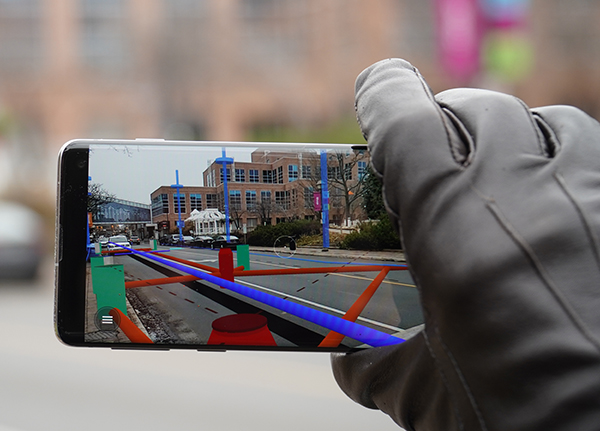The creator of a hybrid augmented reality visualisation platform that combines BIM, CAD and GIS data wants to make it a one-stop-shop for construction, used from project feasibility, through delivery to commissioning.
vGIS transforms BIM models and GIS data into 3D holograms overlaid onto the user’s normal view of the job site. These can be viewed with either a mobile device or a Microsoft HoloLens headset.
The system displays proposed building designs alongside existing underground utility infrastructure, components such as walls, pillars, beams, pipes and foundations can be layered in to build up a detailed picture of current versus planned works.
Around a dozen firms in the UK are using vGIS, including a leading engineering consultant and a main contractor working on a key rail project in England. A total of 80 clients currently use the system worldwide.
Alec Pestov, founder and CEO of vGIS, told BIM+: “Our ultimate aim is to cover all phases of a typical construction project, using the same system for pre-construction, discovery-stage planning, and subsequent construction and commissioning stages. We want to create a comprehensive system that addresses multiple needs using the same tool, instead of a point solution that addresses just, say, model visualisation.”

3D holograms overlaid onto the user’s normal view of the job site can be viewed with a mobile device
The cloud-based platform is configured to automatically extract BIM and GIS data from multiple sources, including Bentley’s iModel-Hub and Esri ArcGIS, simultaneously. Integration with AutoDesk BIM 360 is currently being tested.
“We have written interfaces to pull data directly from all those repositories, so from a workflow perspective, if you’re running a construction or infrastructure project there is no need to maintain a separate model to upload into AR. You just use our platform to visualise the data in AR,” adds Pestov, who claims existing GIS visualisation platforms are either simply model viewers, or only have the processing power to incorporate one data source at a time.
During project feasibility, information supplied by local municipalities, or utility companies, can be uploaded and viewed in context. Surveys of the construction site and local infrastructure can then be added to inform the design. Upon entering the pre-construction phase, engineers can incorporate BIM and infrastructure data to view the design in context, which can also help validate ongoing construction. Post-handover the tool can be used for operation and maintenance purposes or general asset discovery.
vGIS can recognise the identity and location of each user in the field and what information they need to see at any given point in time. AR’s ability to show existing and proposed assets in a project context can result in an improved understanding of surroundings, higher productivity, and fewer errors.
According to Pestov, a professional underground asset detection company was able to save between 12 and 20 hours per employee per month using vGIS, based on a study of all location jobs carried out over the course of five months.
BIM support in vGIS was only rolled out last year and the benefits for construction users have yet to be quantified. “It looks promising, the companies that have started working with us have expanded their use of the system, which is a sign they are seeing benefits,” says Pestov.
The majority of vGIS clients use tablets or smartphones to access AR, but according to Pestov, the flat images and lack of depth perception on touch screens makes it harder to understand complexity and extends the time required to consume visual information.
“True BIM visualisation is better in HoloLens,” he says. “3D objects translate very poorly on a flat screen device, HoloLens is such a natural experience it’s akin to looking at the objects in real life. We expect to see a lot more interest from HoloLens users going forward.”
Comments
Comments are closed.












Great article. I’ve heard many times that AR will benefit construction but I never knew how exactly. This article has highlighted many points and made it clear. I’ll tell my husband (he works in construction.)